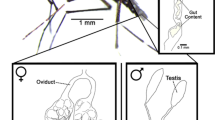Summary
In crosses between populations of the mosquito Culex pipiens of different geographical origin three crossing types have been found (1) crosses with normal offspring (2) crosses with reduced offspring and (3) crosses that show almost total incompatibility. In the case of incompatible crosses 99.9% of the developing embryos are lethal and only about 0.1% of the embryos hatch and develop into fertile diploid females. The origin of the exceptional diploid females has been investigated by means of the marker genes Kuf, r, w, var, y and ru. These females develop from a diploid oocyte or from a diploid nucleus that originated by fusion of the pronucleus and the last polar body. This has been concluded from the frequency of homozygous and heterozygous offspring from heterozygous females, the frequency of equational separation of different genes and the distribution of cross-over gametes in the exceptional females. Based on the genetical data it is argued that induced meiotic parthenogenesis takes place. The sperm does not play any part in the production of the diploid females and the lethal embryos. After the activation of the egg the sperm moves to the center of the egg but it does not succeed to fuse with the pronucleus. As a result the pronucleus starts to develop into a haploid embryo in about 99.9% and only in a few cases is the diploidy restored by a change in the meiotic process in the egg.
Zusammenfassung
Bei Kreuzungen zwischen Culex pipiens-Populationen verschiedener geographischer Herkunft werden drei Kreuzungstypen festgestellt: normale Kreuzbarkeit, reduzierte Kreuzbarkeit und Inkompatibilität (Nichtkreuzbarkeit). Die drei Kreuzungstypen sind mit Hilfe der Embryonierungsrate, der Schlüpfrate und der entstehenden Nachkommenschaft gegeneinander abgrenzbar. Bei Inkompatibilität sind 99.9% der sich entwickelnden Embryonen letal und etwa 0.1% der Tiere schlüpfen und sind fertile, diploide Weibchen. Die Aktivierung des Eies erfolgt durch das Spermium. Es liegt induzierte, meiotische Parthenogenese vor. Die diploiden, parthenogenetischen Weibchen gehen aus einer Oocyte 2. Ordnung oder aus Teilungsprodukten einer Oocyte 2. Ordnung hervor. Bei den letalen, haploiden Embryonen beteiligt sich das Spermium nicht am Aufbau des Embryos.
Similar content being viewed by others
Literatur
Ankel, W. E.: Neuere Arbeiten zur Zytologie der natürlichen Parthenogenese bei Tieren. Z. ind. Abst.- Vererb.lehre 52, 318–370 (1929).
Artom,C.: L'originee l'evoluzione della partenogenesi attraverso i differenti biotipi di una specie colletiva (Artemia salina L.) con speciale riferimento al biotipi diploide partenogenetico d. Sète. Mem. Accad. Ital., Roma, Cl. Sci. Fisiche ecc. 2. Biol. N. 1, 1–57 (1931).
Callan, H. G., Montalenti, G.: Chiasma interference in mosquitoes. J. of Genetics 48, 119–134 (1947).
Comrie, L.: Biological and cytological observations on Tendredinid parthenogenesis. Nature 142, 877–878 (1938).
Jost, E.: Genetische und cytogenetische Untersuchungen zur Kreuzungssterilität im Culex pipiens-Komplex. Dissertation, Mainz (1968).
Laven, H.: Reziprok unterschiedliche Kreuzbarkeit bei Stechmücken (Culicidae) und ihre Deutung als plasmatische Vererbung. Z. Vererbungsl. 85, 118–136 (1953).
Laven, H.: Vererbung durch Kerngene und das Problem der außerkaryotischen Vererbung bei Culex pipiens. I. Kernvererbung. Z. Vererbungsl. 88, 443–477 (1957a).
Laven, H.: Vererbung durch Kerngene und das Problem der außerkaryotischen Vererbung bei Culex pipiens. II. Außerkaryotische Vererbung. Z. Vererbungsl. 88, 478–516 (1957b).
Laven, H.: Speciation by cytoplasmic isolation in the Culex pipiens complex. Cold Spr. Harb. Symp. quant. Biol., 24, 166–173 (1959).
Laven, H.: Speciation and evolution in Culex pipiens. In: Wright, J. W., Pal, R.: Genetics of Insect Vectors of Disease. Amsterdam-London-New York: Elsevier 1967.
Lindsley, D. L., Fankhauser, G., Humphrey, R. R.: Mapping Centromeres in Axolotl. Genetics 41, 58–64 (1956).
McClelland, G. A. H.: Speciation and evolution in Aedes. In: Wright, J. W., Pal, R.: Genetics of Insect Vectors of Disease. Amsterdam-London-New York: Elsevier 1967.
Narbel-Hofstetter, M.: Lesaltérations de la meiose chez les animaux parthenogénétiques. Protoplasmatologia VI, F, 2.1–163 (1964).
Peacock, A. D., Weidmann, M.: Cytologia partenogenezy u zwierzat. Przeglad Zoologiczny V, 2. Engl. Zusammenf. 108–122 (1961).
Prell, H.: Der vererbungstheoretische Charakter der Parthenogenese. Genetica 5, 191–208 (1923).
Seiler, J., Schäfer, K.: Untersuchungen über die Entstehung der Parthenogenese bei Solenobia triquetrella F.R. (Lep., Psychidae). II. Mitt. Analyse der diploiden-parthenogenetischen S. triquetrella. Verhalten, Aufzuchtsresultate und Zytologie. Chromosoma (Berl.) 11, 29–102 (1960).
Smith, S. G.: A new form of spruce sawfly identified by means of its cytology and parthenogenesis. Sci. Agric. 21, 243–305 (1941).
Stalker, H. D.: Parthenogenesis in Drosophila. Genetics 39, 4–34 (1954).
Suomalainen, E.: Parthenogenesis in animals. Advanc. Genet. 3, 193–253 (1950).
Thomson, M.: Studien über die Parthenogenese bei einigen Cocciden und Aleurodiden. Z. f. Zellforsch. 5, 1–116 (1927).
Tucker, K. W.: Automictic parthenogenesis in Honey Bee. Genetics 43, 299–315 (1958).
Vandel, A.: La parthénogenèse. Paris: Dión Frères 1931.
White, M. J. D.: Animal cytology and evolution, 2nd. ed. London: Cambridge University Press 1954.
Winkler, H.: Verbreitung und Ursache der Parthenogenesis im Pflanzenund Tierreich. Jena 1920.
Author information
Authors and Affiliations
Additional information
Teil einer Dissertation der Math.-Nat. Fakultät der Universität Mainz
Danksagung: Herrn Prof. Dr. H. Laven danke ich für die Bereitstellung des Untersuchungsmaterials sowie für die Anregungen bei der Durchführung der Arbeit.
Angenommen durch H. Stubbe
Rights and permissions
About this article
Cite this article
Jost, E. Genetische Untersuchungen zur Inkompatibilität im Culex-pipiens-Komplex. Theoret. Appl. Genetics 40, 251–256 (1970). https://doi.org/10.1007/BF00282034
Received:
Issue Date:
DOI: https://doi.org/10.1007/BF00282034




